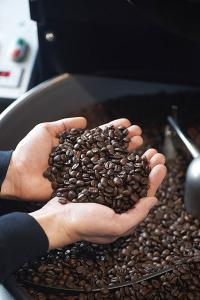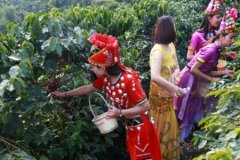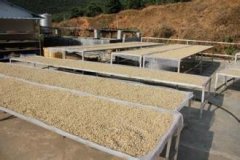A brief introduction to the description of the flavor and aroma characteristics of Cupid coffee beans with moderate sour and bitterness

It is bordered by Costa Rica to the west and the Caribbean to the north. The territory is S-shaped to connect North and South America, and the Panama Canal connects the Atlantic and Pacific oceans from north to south. It is known as the "bridge of the world". [5] Panama has a land area of 75517 square kilometers, a land length of 772km and a width of between 60km and 177km. The coastline is 2988 kilometers long and the land boundary is 555 kilometers long. In terms of longitude and latitude, the Panamanian flag is located between 7 °and 10 °N and between 77 °and 83 °W on November 3, 1904. The national flag is rectangular and the ratio of length to width is 3:2. The flag consists of four rectangles of white, red and blue. White symbolizes peace; red and blue represent the former Panamanian Liberal Party and the Conservative Party respectively, and they are also symbols of the two parties' United struggle for the interests of the nation. The blue star on the white background at the top left represents loyalty and integrity, while the red star on the white background at the lower right represents the authority of the law. The design of the crosshairs divided into four pieces represents that Panama is located at the junction of South America, North America, Atlantic and Pacific Ocean. Red, blue and white are the colors of the American Stars and Stripes that support the independence of Panama. The flag was designed by Manuel Amador Guerrero, the first president of Panama, and the current government of Panama was formed on July 1, 2009. the main members are: vice President Juan Carlos Varela, Minister of the Presidential Office Jimmy Papadi Mittriu, Foreign Minister Fernando Nunez Favre, and State Interior Minister Jorge Ricardo Favre. Minister of Public Security Jose Raul Mulino, Minister of economy and Finance Frank George de Lima, Minister of Commerce and Industry Ricardo Quijano, Minister of Agriculture and Animal Husbandry Development Oscar Armando Osorio Kassar, Minister of Health Javier Diaz, Minister of Housing Yasmina Pimentel (female), Minister of Labour Armah Lorena Cortez (female) Guillermo Ferrufino, Minister of Social Development, Lucy Molina, Minister of Education (female), Minister of Public works, Jaime Ford, Minister of small and medium Enterprises (female), Minister of Canal Robert Roy, Minister of Tourism Salomon Sama
Because of the particularity of this Cupid in variety, we use moderate shallow baking to complete the final flavor trend of this bean, so that it not only has the unique floral aroma, white grape, caramel, honey and black tea, but also has the sweetness and smoothness of honey, the aroma and finish are very long-lasting, and the taste is quite amazing.
Panamanian coffee is classified and numbered into small batches, which are designed to have a small capacity for optimal management, and classification numbers allow buyers to understand and track the entire process.
Because of its small quantity, Panamanian coffee products are based on special coffee. The country provides its high-quality products to specialized stores around the world, such as coffee from Denmark, Britain, Greece, Norway, Sweden, South Korea, Japan, Taiwan Province of China and the United States, which were first brought to Panama by European immigrants in the 19th century. In the past, Panamanian coffee did not have a very good reputation, and its output was only 1 / 10 of that of its neighbor Costa Rica, but now the coffee industry's focus on boutique coffee has made Panama more and more interested in growing coffee. Panama's geographical advantage is that it has many distinctive microclimate areas suitable for coffee cultivation, and Panama also has many persistent and professional coffee growers. This means there will be a lot of very good coffee in Panama, but these coffees are often associated with high prices.
The high price of coffee in Panama is mainly caused by the following factors:
Land price: for the people of North America, they very much want to buy a stable and beautiful land at a low price. Panama is such a place.
More farmers in Panama grow coffee for export in the name of manors to emphasize that their manor Gesha is one of the most primitive coffee varieties in the world. Some people call it "geisha", while others translate it as "Rose Summer". Her name contains tenderness and floral fragrance. It is an unforgettable coffee. It is also the winner of national bidding and cup testing competitions, and has been highly praised. Good geisha coffee will have strong floral and citrus aromas, bright and elegant acidity, soft and clear taste, and extremely meticulous finish!
Boquete is a high-altitude volcanic area, because the Baru Volcano volcano brings quite fertile soil, towering terrain, cold and humid air, different sunshine, abundant rainfall, and rivers flow through it, creating high-quality Panamanian boutique coffee. This batch of coffee, grown in the same area as the Jade Manor, happens to be located in continuous valleys and ridges, so it forms several microclimates, and the coffee produced in different regions has its own flavor. Fresh and comfortable citrus feel, bright patterns of Nanyang fruit, delicate flowers crisscross with a very elegant and generous flavor. In 1931, it was exported to Kenya in obscurity from Geisha Mountain Mountain in southwestern Ethiopia (which happens to be synonymous with Japanese geisha), wandered to Tanzania and Costa Rica, and then transplanted to Panama in the 1960s, and then went through nearly half a century before it became a blockbuster. Beat the victorious Bourbon, Kaddura, Kaduai, Tibica and other varieties to win the first prize of the Panama National Treasure Bean Cup Test Competition in 2005, 2006 and 2007. In 2007, the International famous Bean Cup Test sponsored by the American Fine Coffee Association (SCAA) won the championship again, and the bidding price was sold at US $130 per pound, setting a record for the highest price in the history of competition beans. It is reported that the later Panamanian national treasure bean competition will be divided into two groups: Rose Summer and non-Rose Summer, so as not to be robbed of the brilliance of other varieties by Rose Summer. Rosa is a member of the Tibika family, but it became famous more than 70 years after leaving Ethiopia, and fulfilled the saying that Ethiopia is a treasure trove of Arabica genes. Giving a variety to go abroad is enough to stir up trouble in the coffee market.
This coffee, composed of Rosa, Kaddura and Kaduai, grows in the volcanic area at an altitude of 1600 meters. The treatment plant uses fine honey treatment and traditional washing. The special local microclimate of Panama leads to abundant rainfall in this area and a large temperature difference between day and night, coupled with the unique volcanic soil of the volcanic area, as well as meticulous harvesting and fine treatment. It makes this coffee perform well in terms of richness, acidity and aroma of alpine black tea.
The Baru volcano is not only the highest mountain in Panama, but the sediments created by early volcanic activity and eruption bring a large amount of very fertile soil, which is rich in nutrients, especially rich in phosphorus and sulfur, mixed with clay and a unique climate model, making the region a suitable environment for the growth of high-quality coffee. Dense forests and a large number of species form the overall biodiversity.
About 50 coffee farmers here form a small cooperative, all of which produce coffee in the traditional way of Bogut-allowing it to grow in a near-natural environment. Although the yield is not high, it can maintain a rich ecological environment, and soil quality can be maintained or even improved. The natural planting method is not only beneficial to the environment, because the coffee fruit grows slowly, so it is easier to grow high-quality coffee beans with good flavor. Farmers harvest complete coffee berries by hand and send them to nearby CafedeEletaS.A. For post-processing, the treatment plant is about 4 kilometers away from the farm, and a modern laboratory is set up for cup test tube and manual screening.
What is more surprising is that on the basis of very excellent quality, the very people-friendly price of this coffee bean makes the performance-to-price ratio of this coffee bean. What is special about this coffee bean is that it is made up of three varieties, 30% of which is the famous rose summer, giving this coffee a distinct rose summer flavor.
According to the information obtained from the raw bean merchant, due to the historical reasons of the manor, in order to pursue yield at that time, the early rose summer varieties were mixed with the coffee trees of Kaddura and Kaduai, and in order to facilitate picking, coffee farmers did not reclassify them, but directly mixed the three varieties. After that, as Rosa rose to fame and the price soared, the processing plant began to carry out fine washing treatment + honey treatment for such a coffee bean. The processed coffee tastes clean, emphasizing bright and lively acidity, as well as clear fruit flavor and floral aroma. honey treatment also increases sweetness and caramel taste.
[product name]: Panamanian Cupid
[producing area]: Bogut boquete Baru Volcano region
[variety]: Kaduai, Kaddura, including Rosa Geisha30%
[treatment]: honey treatment and traditional washing
[baking degree]: medium shallow baking
[raw bean specification]: 17-18 mesh
Panama is located on the Panamanian isthmus in Central America, bounded by Colombia to the east and the Pacific Ocean to the south.
Important Notice :
前街咖啡 FrontStreet Coffee has moved to new addredd:
FrontStreet Coffee Address: 315,Donghua East Road,GuangZhou
Tel:020 38364473
- Prev

Guatemala Antigua Flower God Fine Coffee beans with obvious aftertaste of Red Wine
The central plateau is also the cultural center of Guatemala, where temperatures are mild all year round between 1300 and 1800 Michael, with daily temperatures between 18 and 28 ℃, and higher levels tend to be colder in January and February. The annual precipitation is 2000-3000 mm in the northeast and 500-1000 mm in the south, while the ecological conditions in the south are very suitable for the growth of high-quality Arabica trees. And even more special.
- Next

A brief introduction to the origin, development, history and culture of Cupid boutique coffee beans
[product name]: Panama Cupid [producing area]: Bogut boquete Baru Volcano region [Variety]: Kaduai, Kaddura, Rosa Geisha30% [treatment]: honey treatment and traditional washing [baking degree]: moderately shallow baking [Bean Specification]: 17-18 mesh Panama is located on the Panamanian isthmus of Central America, bordered by Colombia to the east and the Pacific Ocean to the south.
Related
- Detailed explanation of Jadeite planting Land in Panamanian Jadeite Manor introduction to the grading system of Jadeite competitive bidding, Red bid, Green bid and Rose Summer
- Story of Coffee planting in Brenka region of Costa Rica Stonehenge Manor anaerobic heavy honey treatment of flavor mouth
- What's on the barrel of Blue Mountain Coffee beans?
- Can American coffee also pull flowers? How to use hot American style to pull out a good-looking pattern?
- Can you make a cold extract with coffee beans? What is the right proportion for cold-extracted coffee formula?
- Indonesian PWN Gold Mandrine Coffee Origin Features Flavor How to Chong? Mandolin coffee is American.
- A brief introduction to the flavor characteristics of Brazilian yellow bourbon coffee beans
- What is the effect of different water quality on the flavor of cold-extracted coffee? What kind of water is best for brewing coffee?
- Why do you think of Rose Summer whenever you mention Panamanian coffee?
- Introduction to the characteristics of authentic blue mountain coffee bean producing areas? What is the CIB Coffee Authority in Jamaica?

